From the Archives: Sound Approach and Dutch Birding at Kazbegi
Taken from Dutch Birding Journal 27, 2005
Written by Arnoud B van den Berg and The Sound Approach
From at least 1998, and especially since the ‘Rose Revolution’ in November 2003, travelling to Georgia has been on the increase and more and more birders seize the opportunity to visit the Greater Caucasus. In species’ diversity, this high mountain range with four peaks over 5000 m (including Europe’s highest mountain peak, mount Elbrus (Gora El-brus) with 5633 m) offers the best alpine birding in the WP with specialities like Caucasian Grouse Tetrao mlokosiewiczi, Caucasian Snowcock Tetraogallus caucasicus, Güldenstädt’s Redstart Phoenicurus erythrogastrus and Caucasian Great Rosefinch Carpodacus rubicilla, and other much sought-after montane species as Lammergeier Gypaetus barbatus, Alpine Accentor Prunella ocularis, Rufous-tailed Rock Thrush Monticola saxatilis, Wallcreeper Tichodroma muraria, White-winged Snowfinch Montifringilla nivalis, Red-fronted Serin Serinus pusillus and both choughs Pyrrhocorax. In addition, a number of WP species are represented here by subspecies differing so much in plumage and/or vocal repertoire that they are easily recognized like, for instance, Caucasian Horned Lark Eremophila alpestris penicillata, Caucasian Wren Troglodytes troglodytes hyrcanus, Caucasian Ring Ouzel Turdus torquatus amicorum and Turkish Twite Carduelis flavirostris brevirostris. Although some may even be regarded as specifically distinct from taxa further west, they are largely ignored in even the best WP field guides (cf Jonsson 1996, Svensson et al 2000)
Geography and Logistics
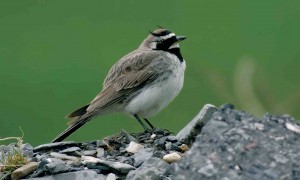
Caucasian Horned Lark / Kaukasische Strandleeuwerik Eremophila alpestris penicillata, Krestovy pass at 2300 m elevation, Khevi, Georgia, 26 June 2005 (Arnoud B van den Berg)
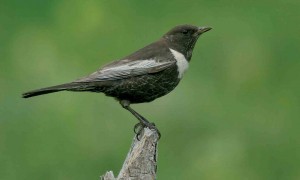
Caucasian Ring Ouzel / Kaukasische Beflijster Turdus torquatus amicorum, near Kobi, Khevi, Georgia, 21 June 2005 (René Pop)
The alphabet is Georgian but Russian is spoken as a second language, as is English by young people. The drive from Tbilisi to Kazbegi takes 3-4 hours. Taxis or minibuses from the Didube bus station in Tbilisi to Kazbegi cost 5-20 USD a person (Burford 2002, Gavashelishvili et al 2005). The road’s surface is reasonable until the resort town of Gudauri but its last 40 km from Gudauri up to the border is in a very bad state with numerous potholes and crumbling avalanche tunnels. This latter section, however, offers excellent birding at, eg, the Divari or Krestovy pass at 2379 m, 127 km from Tbilisi and 26 km before Kazbegi. Here, even by early June (Calum Scott in litt), there are chances to see Caucasian Grouse, Alpine Accentor, White-winged Snowfinch and Caucasian Great Rosefinch. From this pass onwards, the highway follows the Terek (Tergi) river downstream towards Kazbegi (1800 m) and the Russian border 6 km further north. There are only a few hotels, bed-and-breakfasts, and shops at Kazbegi or the adjacent Gergeti village, which is situated on the other (western) side of the Terek river. The new Stepantsminda Hotel at Kazbegi offers comfortable accomodation and a good restaurant for 30 USD including breakfast and dinner, or 20 USD without meals (telephone +99-599182296 or +99-577420210). On 20-26 June 2005, René Pop and I stayed at Kazbegi for The Sound Approach project in order to record on tape the sounds of Caucasian Snowcock and Caucasian Great Rosefinch (the latter has been ‘split’ from Spotted Great Rosefinch C (r) severtzovi which occurs from Afghanistan east through the Himalayas;
Rasmussen 2005). The Georgian Center for the Conservation of Wildlife (www.gccw.org) offered us invaluable assistance with information and transport between the Tbilisi airport and Kazbegi. From its office at the Nutsubidze Plateau in Tbilisi, the GCCW is active in several nature conservancy projects and promotes birding and ecotourism (see, eg, Gálvez et al 2005, Gavashelishvili 2005, Gavashelishvili et al 2005, www.birding-georgia.com).
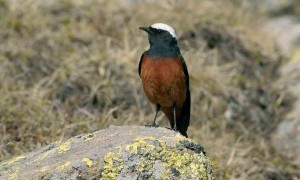
Güldenstädt’s Redstart / Witkruinroodstaart Phoenicurus erythrogastrus, male, mount Kazbeg at 3000 m elevation, Kazbegi, Khevi, Georgia, 24 June 2005 (René Pop)
Birding localities and timing In late April and early May, the snow line is usually below 1900 m which means that altitudinal migrants can still be found in the river valley, especially in the dense bushes of Sea Buckthorn (‘duindoorns’ in Dutch) Hippophae rhamnoides south of Kazbegi. For instance, after heavy snowfall on 4 May 2005, no less than up to 60 Güldenstädt’s Redstarts and a flock of at least 250 Caucasian Great Rosefinches were found here (Birding World 18: 200, 2005). These bushes also form an important shelter for many long-distance migrant passerines in this period (which is why GCCW tries to give full protection to this vegetation). Further along the highway, there are several other gorges and woods for birding and, especially in early May, one may expect 100s of migrating raptors. However, the most tempting birding areas at Kazbegi are the mountain slopes at either side of the village, mount Kuro to the east and mount Kazbeg to the west. The steep slopes of Kuro form the best site to see Caucasian Grouse and Caucasian Snowcock.The area is easily reached by walking c 2 km east from the Stepantsminda Hotel through the village and an open pine wood until a small chapel is reached with a little pond south of it. In April-May, Caucasian Grouse can be seen displaying on the grassy slopes across the noisy little river running down from Kuro.
From the first week of June, when displaying has stopped, they become very hard to find as they hide in low Rhododendron vegetation. Caucasian Snowcock remains vocal through spring and summer and can be spotted by telescope on precipitous rocks or when flying. During summer, it gradually moves higher, following the snow line. On hot days in late June, the little pond at the base of Kuro attracts a variety of birds including Caucasian Ring Ouzel, Mistle Thrush T viscivorus, Common Linnet C cannabina, Turkish Twite and Red-fronted Serin. The adjacent pine wood has, for instance, singing Bright-green Warbler Phylloscopus nitidus, Caucasian Chiffchaff P lorenzii, Coal Tit Parus ater and Common Rosefinch C erythrinus. From late May or early June, it is necessary to climb to 2600 m to find the CaucasianGreat Rosefinch and to 3000 m and higher for Güldenstädt’s Redstart, so there is no other option at Kuro than to start climbing the steep grassy slopes to the right. After c five hours, the first Caucasian Great Rosefinches can be expected and here are some good vantage points to check rocky outcrops for Caucasian Snowcocks, which are most vocal at dusk and dawn. One should climb even higher to encounter Güldenstädt’s Redstart but it may be possible to find it by checking high snow fields by telescope. Other species on these steep slopes include the abundant Caucasian Water Pipit Anthus spinoletta coutellii, Alpine Accentor, Rufous-tailed Rock Thrush and Asian Crimson-winged Finch Rhodopechys sanguineus sanguineus.
Further up, it gets (too) difficult to walk as there are some very steep slopes covered by loose rocks instead of grasses. We camped one night up here but it was hard to find a level spot. Instead of spending the night, one may also decide to climb up in the early morning and to return before dusk. On the western side of Kazbegi, the walk to the 3652 m high metereological station above the c 7 km long glacier of mount Kazbeg is more level than the walk up Kuro and therefore it is easier to do albeit longer in distance. From the Stepantsminda Hotel, which is situated next to a little riverside park with breeding Common Sandpiper Actitis hypoleucos and many passerines, one follows the sign left to Vladikavkaz, Russia, crossing the bridge over the Terek river, and then one immediately turns left up to the Gergeti village. In Gergeti, Caucasian Black Redstart P ochruros ochruros and Marsh Warbler Acrocephalus palustris are common amongst the houses.
All in all, it is less than a c 60 min walk from Kazbegi to the Tsminda Sameba church (2170 m) which overlooks the Terek valley of Kazbegi-Gergeti. On the way, we passed birch woods with dense ground cover of herbs and flowers where Caucasian Wren, Bright-green Warbler and Caucasian Chiffchaff were abundant while other species included Corn Crake Crex crex, Tree Pipit A trivialis, Caucasian Ring Ouzel, Common Blackbird, Mistle Thrush, Ehrenberg’s Redstart P phoenicurus samamisicus, Common Treecreeper Certhia familiaris caucasica, Long-tailed Tit Aegithalos caudatus major, Red-fronted Serin, Eurasian Bullfinch Pyrrhula pyrrhula and Eurasian Jay Garrulus glandarius krynicki. The nicest and shortest way uphill is a path following a brown metal water pipe which is obvious from above the cemetery. There is also a zig-zagging rocky track to the church and one may opt to shorten the climb by taking a 4WD taxi from the hotel for at most 10 USD per person. Actually, for those with physical problems, there is also the option of renting a helicopter for 1500 USD per hour to pick you up in Kazbegi and to drop you next to the Kazbeg glacier; the machine can take more than 10 persons which can cut the price down considerably and, if it is already in nearby Gudauri, the rental time may be less than an hour. Because of the unpredictable weather the planning of a helicopter flight might be problematical and it seems wise not to count on a return flight but to walk the four hours back to Kazbegi. As soon as one emerges from the birch woods on the walk up, c 200 m before reaching the church, it is straightforward to follow trails to mount Kazbeg to the right.
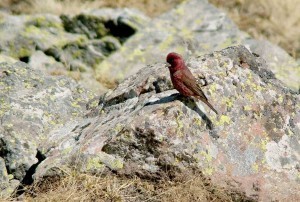
Caucasian Great Rosefinch / Grote Roodmus Carpodacus rubicilla, male, mount Kazbeg at 2900 m elevation, Kazbegi, Khevi, Georgia, 24 June 2005 (René Pop)
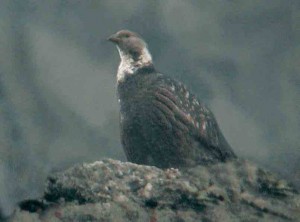
Caucasian Snowcock/Kaukasisch Berghoen Tetraogallus caucasicus, mount Kuro, Kazbegi, Khevi, Georgia, 12 June 2005 (Calum D Scott)
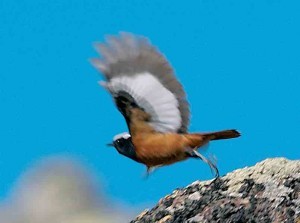
Güldenstädt’s Redstart / Witkruinroodstaart Phoenicurus erythrogastrus, male, mount Kazbeg at 3000 m elevation, Kazbeg, Khevi, Georgia, 24 June 2005 (René Pop)
The easiest trail is along the southern side of the high grassy ridge while the canyon at the northern side may offer more birding possibilities. After c 11 km from the church, one reaches the edge of the glacier’s snout which happened to be the only area where our mobile phones did not work. Parts of the trail were still snow-covered in late June. The glacier area is exceptionally beautiful and it is recommended to stay overnight to experience both the late afternoon and the early morning bird activity. The weather station is situated a few 100 m above the glacier and, by late June, it was still surrounded by snow and too difficult to reach (it is used as a base for mountaineers aiming to reach the 5033 m peak of Kazbeg). We camped in the grassy area aside the glacier’s snout at 2950 m, where one has to be prepared for sudden weather changes with snowfall, frost, rain, dense fog and forceful winds, all possible in a single night.
Left (south) of the glacier, we checked some scree slopes surrounded by snow and that is where we found two or three male Güldenstädt’s Redstarts and several Caucasian Great Rosefinches. As soon as we had learned its song, the latter appeared quite common and was regularly heard throughout the day above 2600 m. Other species we found near the Kazbeg glacier included Lammergeier, Eurasian Griffon Vulture Gyps fulvus, Golden Eagle Aquila chrysaetos, Eurasian Eagle Owl Bubo bubo, Caucasian Snowcock (only one or two singing), Alpine Swift Apus melba, Black-bellied Dipper Cinclus cinclus caucasicus, Caucasian Water Pipit, Alpine Accentor, Caucasian Black Redstart and Wallcreeper.
Chris Batty, Phil Benstead, Kris De Rouck, Hugues Dufourny, Ramaz Gokhelashvili, Georges Olioso, Giorgi Rajebashvili, Magnus Robb and Calum Scott helped in supplying information about the birding in Kazbegi. The Georgian Center for the Conservation of Wildlife (GCCW) at Tbilisi, Georgia, offered invaluable assistance (www.gccw.org).
References
- Alfrey, P & Spittle, D 2004. Birding the Greater Caucasus, Georgia. Birding World 17: 255-257.
- Benstead, P 1998. On the edge of Asia. Birding World 11: 398-399.
- Burford, T 2002. Bradt travel guide: Georgia with Armenia. Second edition. Chalfont St Peter.
- Gálvez, R A, Gavashelishvili, L & Javakhishvili, Z 2005. Raptors and owls of Georgia. Tbilisi.
- Gavashelishvili, L 2005. Vultures of Georgia and the Caucasus. Tbilisi.
- Gavashelishvili, L, Gokhelashvili, R, Javakhishvili, Z & Tarkhnishvili, D 2005. A birdwatching guide to Georgia. Tbilisi.
- Jonsson, L 1996. Vogels van Europa, Noord-Afrika enhet Midden-Oosten. Fourth edition. Baarn.
- Rasmussen, P C 2005. Revised species limits and field identification of Asian rosefinches. Birding Asia 3:18-27.
- Svensson, L, Grant, P J, Mullarney, K & Zetterström, D 2000. ANWB-vogelgids van Europa. Baarn.
- Tucker, G 2003. High hopes. Birdwatch 12 (138): 34-37.
Re-printed with kind permission from Dutch Birding Association